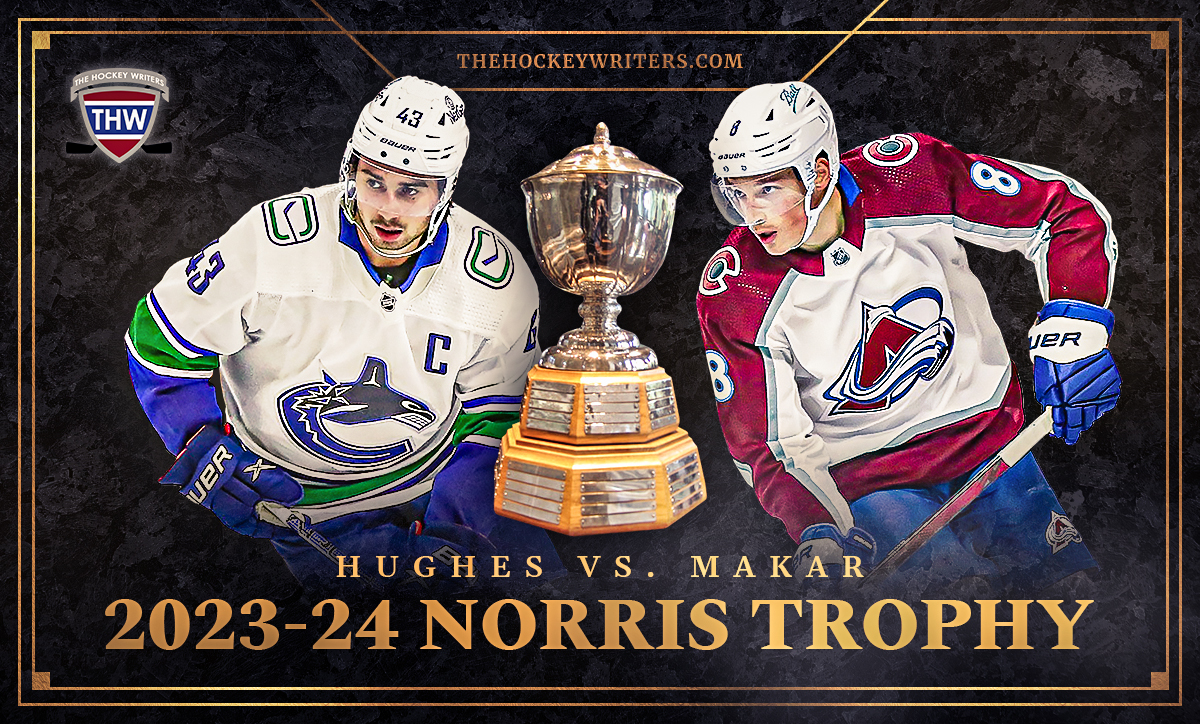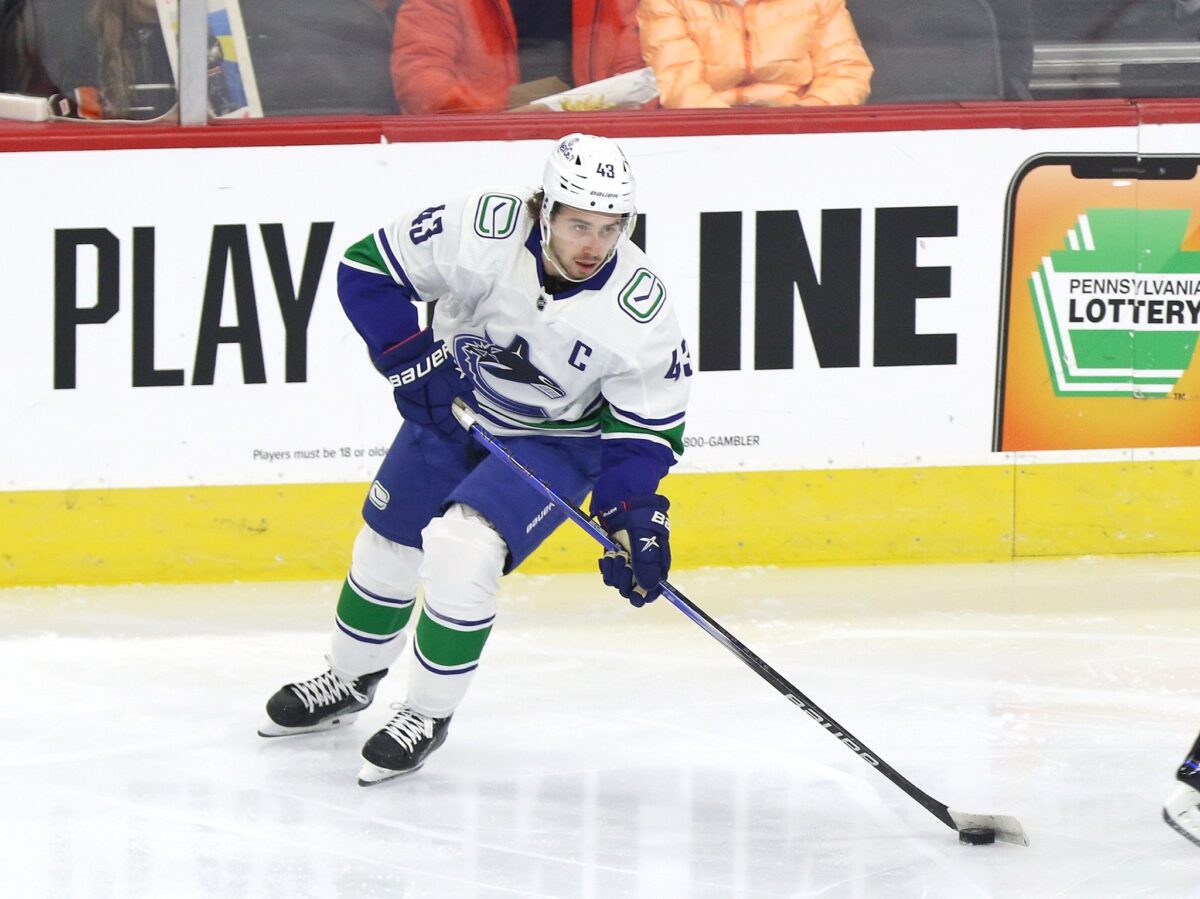With the NHL calendar set to turn to December and all but two teams playing between 18 and 22 games, we’ve reached the quarter-mark of the 2023-24 season. As such, it’s an appropriate time to analyze and evaluate the early returns in one of the most intriguing storylines of the campaign.
The race for the 2023-24 Norris Trophy is shaping up to be an all-timer as two names have clearly outstripped the rest of the pack in the early going – Quinn Hughes of the Vancouver Canucks and Cale Makar of the Colorado Avalanche. The two defenders represent the pinnacle in the evolution of the modern NHL defenseman, defying the limitations of the position and playing a more expansive and rover-like role in all three zones.
As the pair have opened up 10- (Hughes) and seven-point (Makar) leads over Victor Hedman (22 points) in the defenseman scoring race, the Western Conference rearguards have distanced themselves from their positional peers in the offensive realm.
In fact, both would be right at home in the Hart Trophy discussion as the league’s most valuable player, which further explains my reasoning for limiting the scope of this piece to just these two rearguards.

For a glossary of the metrics used later on in this article, read The Hockey Writers’ advanced analytics primer which should help expand your horizons when it comes to player evaluation.
Without further ado, let’s dive into how Hughes and Makar compare in a number of possession-based metrics, offensive production, deployment, and usage across all game states and situations to offer an early judgment on the Norris race.
Hughes vs. Makar: Shot and Chance Metrics
The first battleground is in the realm of possession and how each of Hughes and Makar fare in their respective on-ice shares of shots (SF), expected goals (xGF), scoring chances (SCF), high-danger chances (HDCF), and goals (GF) at five-on-five.
| Hughes | Statistic (%) | Makar |
|---|---|---|
| 51.7 | SF | 55.6 |
| 48.4 | xGF | 58 |
| 54.4 | SCF | 56.9 |
| 50 | HDCF | 57.7 |
| 69.4 | GF | 63.6 |
Makar holds a significant lead over Hughes in four of five categories, sitting 22nd or better league-wide among qualified defenders (minimum 100 minutes played at five-on-five). This means that the Avalanche account for a greater proportion of the aforementioned statistics when he is on the ice, compared to how the Canucks fare with Hughes on the ice.
The only category in which Hughes beats Makar is in his share of goals for at five-on-five with the Canucks responsible for 69% of all goals with Hughes on the ice, outscoring opponents 25-11 (plus-14) when he plays. In comparison, the Avalanche have outscored opponents 21-12 (plus-9) with Makar.
I must note two key caveats, however. Raw on-ice results are not adjusted for usage, deployment, or team results, meaning the numbers lose some context when presented in this fashion. Relative metrics – which compare how a team plays with a player compared to without – are a way to bridge the gap, and will be addressed in the next section.
The second caveat is that goal-share, while informative, does not tell you anything about two of the most important factors – the goaltender and shooting luck.
If a team has the luxury of starting an elite goaltender (like Thatcher Demko in Vancouver), they are less likely to give up goals which more often than not, has little to do with the traits of any given player. It’s also the category most subject to variance and particularly so in small samples (such as 20 games into a season), so some caution should be exercised when touting it over other, more stable metrics such as shot- and chance-share where Makar leads handily.
 Hughes ranks fifth among all qualified defensemen in PDO (shooting percentage plus save percentage) at five-on-five, suggesting that he’s due for a (slight) regression in scoring and that his goal-share may not look as pretty further into the season. For what it’s worth, Makar ranks 30th, though the pair’s above-average skill levels should help buffer the fall.
Hughes ranks fifth among all qualified defensemen in PDO (shooting percentage plus save percentage) at five-on-five, suggesting that he’s due for a (slight) regression in scoring and that his goal-share may not look as pretty further into the season. For what it’s worth, Makar ranks 30th, though the pair’s above-average skill levels should help buffer the fall.
Advantage: Makar
Hughes vs. Makar: Relative Metrics
To illustrate the need for relative metrics, let’s use the example of how the Avalanche and Canucks fare at five-on-five. The Avalanche rank fourth in the league in xGF (55.1%) and SCF (55%), and third in HDCF (56.5%). In comparison, the Canucks rank 23rd in xGF (48.5%), 18th in SCF (49.5%), and 27th in HDCF (46.9%). Overall, the Avalanche are a much stronger team in this game-state, so it follows that Makar would have better raw results.
Relative metrics isolate each player’s performance to help better demonstrate how important each player is to their team’s success. Without Makar, the Avalanche likely remain an above-average club at five-on-five. Without Hughes, the Canucks might be more interested in the 2024 NHL draft class than the playoff race.
| Hughes | Relative Statistic (%) | Makar |
|---|---|---|
| +4.5 | SF | +0.4 |
| -0.1 | xGF | +4.5 |
| +7.8 | SCF | +2.8 |
| +5 | HDCF | +1.7 |
| +13.9 | GF | +17.6 |
While Makar still manages to make a postive relative impact on a Stanley Cup contender, Hughes outranks him in every category but xGF and GF, though I already explained why goal-share should be appraised with some apprehension. In case you’re confused, the results shown above mean that the Canucks account for 4.5% more of all shots on net at five-on-five when Hughes is on the ice, versus when he’s on the bench, and so on and so forth.
Now, it’s easier to post more favorable relative metrics when the baseline is much lower as is the case with the Canucks, but that shouldn’t wholly take away from Hughes’ impact on the run of play this season. He can only account for his own play, and he’s put up some of the best relative metrics at his position this season.
Advantage: Hughes
Hughes vs. Makar: Offensive Production
At the time of this writing, Hughes leads all defensemen with eight goals and 32 points in 21 games. Makar has scored five times and tallied 29 points in 19 games, slightly edging out Hughes in per-game production (1.53 to 1.52). As I mentioned earlier, both are at least seven points clear of Hedman in third, so no one else has approached their scoring rates so far this season.
Makar is tied with Nikita Kucherov for the league lead in primary assists (A1) with 14, though Hughes only sits one behind (13). Hughes leads all defenders with 21 primary points (P1), while Makar sits two back with 19. The pair are tied with 14 points at five-on-five, while Hughes counts 14 powerplay points to Makar’s 10.
Rather than focus on the raw totals, I’m using their per-60-minute rates of scoring which adjusts for total time on ice, which is important since Hughes currently has two more games played and 54 more minutes played than Makar.
| Hughes | Statistic (Per-60) | Makar |
|---|---|---|
| 0.97 | G | 0.62 |
| 1.3 | A | 2.24 |
| 0.65 | A1 | 1.02 |
| 2.27 | PTS | 2.86 |
| 1.62 | PTS1 | 1.64 |
| 0.21 | xGF | 0.43 |
The numbers don’t lie. On a per-60-minute basis, Makar is outpacing Hughes in every category at five-on-five apart from goals, and doing so by a healthy margin except for their rate of primary contributions. Makar isn’t just feasting out on secondary assists, accumulating nearly 0.5 primary assists – those directly leading to a goal – more than Hughes per-60.
The general public and voters should hold five-on-five production in higher regard, though I understand why some don’t given that scoring on the power play still requires a combination of skill and execution. Hughes beats out Makar in powerplay assists (third among defensemen), and points (fifth) per-60-minutes, though Makar sits higher in goals (32nd) and primary assists (fourth). Those numbers improve Hughes’ standing in all-situations production, but not by much.
| Hughes | Statistic (Per-60) | Makar |
|---|---|---|
| 0.93 | G | 0.65 |
| 2.8 | A | 3.13 |
| 1.51 | A1 | 1.82 |
| 3.73 | P | 3.78 |
| 2.44 | P1 | 2.47 |
| 0.36 | xGF | 0.56 |
According to MoneyPuck, Hughes leads all defensemen in goals scored above expected (five) while Makar’s actual goal total is even with his expected goals number. Hughes’ increased goal-scoring could very well be attributed to natural progression and improvement, the fact that his shooting percentage (SH%) this season (12.7%) is exactly double his previous career-high of 6.5% doesn’t exactly scream sustainable.
I’d expect Makar to eventually outstrip Hughes in goals since he’s generating almost double the expected goals at five-on-five, and slightly less in all situations. That he’s producing more efficiently than Hughes in all situations is notable since as I alluded to before, he’s played 60 minutes to Hughes’ 23 on the penalty kill.
Hughes is undoubtedly hitting new heights and is much closer to Makar than ever before, but the Avalanche superstar still outpaces him when it comes to adjusted scoring.
Advantage: Makar
Hughes vs. Makar: Usage and Deployment
With the juiciest area of comparison completed, let’s move on to usage and deployment, using the statistics of ice time per game (ATOI) and offensive zone start ratio (OZSR), as well as looking at most common linemates.
| Hughes | Statistic | Makar |
|---|---|---|
| 17:41 | ATOI | 15:28 |
| 1:07 | ATOI (Penalty Kill) | 3:11 |
| 24:31 | ATOI (All Situations) | 24:13 |
| 58.3 | OZSR (%) | 67 |
While Hughes ranks within the top 50 of all defenders in ATOI at five-on-five, Makar sits outside the top 100 league-wide, though both are in the top 20 by overall usage.
Makar makes up for the even-strength discrepancy by playing over two minutes more than Hughes on average while shorthanded, suggesting that he has the confidence of his coaches in more defensively vulnerable situations. That doesn’t necessarily mean that he’s better than Hughes in those situations especially since strategy and linemates play a massive role, but the difference is telling.
For what it’s worth, the Avalanche’s penalty kill ranks third in the NHL with a 93.4% efficiency-rate, while the Canucks sit 14th with a 83.8% kill-rate. Colorado’s penalty kill also ranks top 10 in the league in terms of shots, chances, and expected goals conceded per-60-minutes, while the Canucks are comfortably in the bottom-third by those same metrics.
Makar (4:23) and Hughes (4:19) are within five seconds of one another in average ice time on the power play, so we can’t say that one is getting more favourable treatment in that regard. Hughes does quarterback a top-five powerplay (29%) while Makar’s Avalanche sit middle-of-the-pack, so that’s a notch on his belt.

Makar’s most frequent linemates at five-on-five are Devon Toews (his defensive partner), Nathan MacKinnon, Mikko Rantanen, and Valeri Nichushkin, in that order. Hughes’ most frequent linemates are Filip Hronek (his partner), Brock Boeser, J.T. Miller, and Phillip Di Giuseppe, with Elias Pettersson not far behind.
Given their Stanley Cup pedigree and more decorated NHL tenures, it’s hard to argue that Makar has been given a stronger supporting cast than Hughes at five-on-five, which harkens back to my point about relative metrics. It’s hard to fault the Avalanche since playing your stars together gives you the best chance to win, but it also gives Hughes the edge in this department.
Advantage: Hughes
2023-24 Norris Trophy Race Too Close to Call
If the season ended today, both Hughes and Makar could make credible arguments for their respective claims to the Norris based on their play to date. The pair have raced ahead in the positional scoring race and have been clear driving forces in their team’s early success at both ends of the ice.